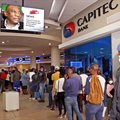Soon after the lockdown in April 2020, I visited Eyethu Mall in Orange Farm. I was amazed to see how full the mall was, despite the Covid outbreak. Unlike in high end malls, where you saw only a few people, in Eyethu people were queuing in the chairs provided, waiting to be allowed into shops.
As it turns out, this is not so surprising. There have been many reports of the resilience of mid to lower LSM malls during the pandemic. During the level 3 and 4 lockdown levels, these malls experienced on average a 6 – 10% drop in their foot traffic, and have since mostly recovered. This is a long way from the experience of high end malls, where foot traffic is reported to have plummeted, and which still remain quiet. This resilience is also reflected in the financial performance of companies invested in the mid to low end retail sector, including Fairvest, who own Bara precinct, and Vukile Property Fund.
Why are middle market malls so resilient?
More than ever, people want to shop as close to home as possible – so if there is a mall close by, that is where they go. These malls supply many essential goods and services – grocery shops, banks, pharmacies – meaning that people continue to visit them to buy necessities.
And while online shopping has grown rapidly during the pandemic, it’s still only used by a minority of South Africans. In May 2021, World Wide Worx reported that “the percentage of retail made up by online retail sales came to 2.8% – exactly double the percentage for 2018”. But for many people in the townships, the high cost of data, lack of internet access and delivery infrastructure, and perhaps a lack of trust in online shopping and payment methods, all mean that people still visit retail stores, and will continue to do so.
Some retailers – DisChem, for example – offer shoppers free WiFi, attracting people who don’t otherwise have internet access.
Finally, going to the mall is not just a shopping trip: Malls have become a part of the fabric of their communities, a place to go for distraction, entertainment and social connection. So when the restrictions were lifted, people flocked to these malls.
What people get wrong about middle market malls
There are many misconceptions around these developments. One is that the people who shop at middle market malls are poor and prefer cheap brands. The reality is that this market (LSM 5-8) has buying power of R11bn and there’s a growing demand for high-end stores. Retail Brief reports that depending on the region, the average spend per person is around R60 to R120 per day: if you add up all those weekly sales, this is something that brands can’t afford to ignore.
Second, people believe that these malls are small, ugly and have only a limited range of shops, when in fact the average size of these developments has roughly tripled post 1994, with billions spent on development and maintenance. Take for example, Umlazi Mega City’s R379m revamps and the recently announced R1.2bn Atteridgeville Mall development. Brands such as Woolworths and PicknPay are aggressively expanding into these malls, as are banks, DisChem, Pep, Mr Price and OBC Chicken. A wide mix of brands are recognising the value of these sites, and their importance in the community.
Finally, there is concern that these new developments negatively affect the surrounding community, especially as new malls can deplete local businesses. This is a valid point, which some developments are trying to address. On the other hand, they also create jobs during and after construction, bring improvements in local infrastructure, and become an active part of the community, providing a safe space for sellers and buyers.
A missed opportunity
Despite the growing number of malls serving the middle market, there is still very little advertising media to be found in many of them – maybe a billboard outside, but usually not a lot more. This represents a missed opportunity for marketers to reach middle market shoppers in LSM 5-8 – and around 81% of urban South African adults fall within this category.
Adding touchpoints to the shopper journey
Our take is that this is a largely untapped market, one that brands can’t afford to ignore. So, over the past year we have rapidly intensified our move into these malls, rolling out Mall TV in 21 malls in high density areas in Gauteng, Western Cape and KZN – to reach an estimated audience of 20 million people a month.
Mall TV is a digital placed based network consisting of a network of high-definition screens placed in strategic positions throughout LSM B malls nationally. Mall TV offers shoppers both relevant content and advertising which adds tremendous value to their overall shopping experience.
Traditionally this LSM consumer group has been reached through radio, TV, transit and billboards. The obvious advantage of adding mall advertising to this mix is that you amplify your message, and reach shoppers just before the point of purchase.
Instead of focusing on individual malls, our advice to marketers is this: Don’t choose a mall – buy it as if you are buying a normal LSM 5-8 campaign on TV. By taking a small fraction of your TV or digital media budget and using this to extend your campaign into these malls, you can reach people who haven’t been exposed to your TV ads, and amplify your message for those who have. Don’t ignore this market.
¹ Retail Brief Africa, 1 July 2020
² Retail Brief Africa, 1 July 2020
³ https://cberuk.com/cdn/conference_proceedings/2020-09-08-13-38-51-PM.pdf
⁴ Source: ROAD 2015/16/17C
⁵http://www.worldwideworx.com/online-retail-in-sa-2021/

